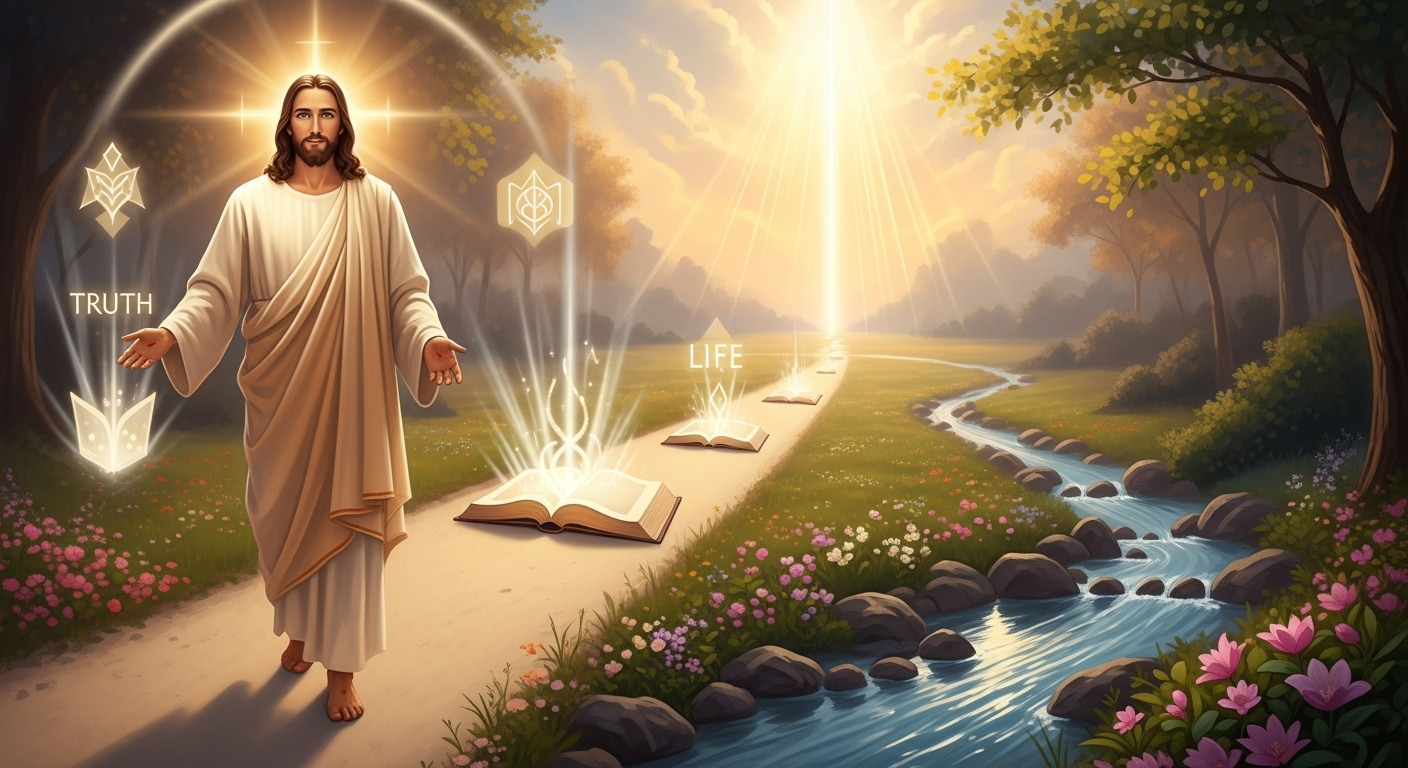What ‘I Am the Way, the Truth, and the Life’ Truly Means (John 14:6 Explained)
In John 14:6, Jesus Christ makes a profound declaration about His divine identity and role. He states, ‘I am the way, the truth, and the life. No one comes to the Father except through me.’ This means Jesus is the exclusive path to God (‘the way’), the ultimate embodiment of all reality and divine revelation (‘the truth’), and the source of eternal salvation (‘the life’). This statement affirms that faith in Jesus Christ is the only means of reconciliation with God the Father.
Imagine a moment when every doubt dissolves and every question finds its answer. Amid His disciples’ anxiety over His imminent departure, Jesus spoke words of unparalleled power and clarity: “I am the way, the truth, and the life. No one comes to the Father except through me” (John 14:6). This is not just a comforting promise; it is a divine declaration that shapes the very core of Christian faith.
This profound statement from Jesus Christ is a foundational truth of Christianity—a compass for our souls and the blueprint for salvation. It proclaims that Jesus is the sole means by which we can truly know God and experience eternal life. In a world filled with diverse beliefs and competing philosophies, understanding the depth of these words is more crucial than ever. It is essential for believers seeking a deeper walk with Him and for those curious about the heart of the Gospel.
Join us as we unpack the rich meaning behind the phrase, “I am the way, the truth, and the life.” We will explore the specific circumstances that led to this profound utterance. Discover why Jesus chose this pivotal moment to reveal such an essential aspect of His identity and mission, offering assurance to troubled hearts then, and to ours today.
What is the Context of John 14:6?
Thomas’s Question and Jesus’s Divine Answer
On the solemn night before His crucifixion, Jesus gathered with His beloved disciples in the Upper Room. Knowing His earthly time was short, He spoke openly of His impending departure, intending to comfort their heavy hearts. “Let not your heart be troubled,” He urged, “you believe in God, believe also in Me” (John 14:1). Jesus then promised to prepare a special place for them, assuring them He would return to take them to be with Him (John 14:2-3).
Then, Thomas, one of the disciples, voiced a crucial question born of a genuine need for clarity: “Lord, we do not know where You are going, and how can we know the way?” (John 14:5). In response, Jesus gave a profound and deeply revealing declaration: “I am the way, the truth, and the life. No one comes to the Father except through Me” (John 14:6).
This was not a suggestion for a path but a divine claim of identity—Jesus *is* the path itself. His identity is inseparable from the means of our salvation, and this statement powerfully affirms His deity. Only God could make such an absolute declaration, one that highlights His unique role in redemption as the only one who bridges the gap between humanity and the Father.
Assurance for Troubled Hearts
As their beloved Lord spoke of leaving them, the disciples felt great sorrow and faced an uncertain future. However, Jesus’s words in John 14 offered immense comfort because He understood their fear and confusion. His divine declaration became an anchor for their souls, offering unwavering hope amidst despair.
Because Jesus *is* the way, we have clear guidance and will not wander aimlessly. His truth brings perfect clarity, dispelling doubt and deception, while the life He offers—both eternal and abundant—conquers death itself. Therefore, Jesus’s statement in John 14:6 is a firm promise of God’s unfailing provision, limitless love, and guaranteed access to the Father. This profound truth brings deep peace to believers, calming even the most troubled hearts. Today, we can rest securely in His divine sovereignty and trust in His completed work on the cross, for Jesus is our Lord, Savior, and sure living hope.
What is the meaning of ‘I am the way, the truth and the life’?

Jesus as ‘The Way’: The Only Path to the Father
When Jesus declared, “I am the way,” He made a profound and exclusive claim. He wasn’t offering one path among many; He was presenting Himself as the singular, divinely appointed path to God the Father. This means that through Him alone, we find access to God, forgiveness for our sins, and eternal salvation. No other spiritual roadmap leads to true communion with the Creator.
Consider this analogy: humanity’s sin creates an impassable chasm between us and a holy God. Through His perfect life, sacrificial death, and resurrection, Jesus became the one and only bridge across that chasm (Romans 3:23-25). By fulfilling the law and perfectly pleasing the Father, He made the way for us.
Therefore, seeking God apart from Jesus is like embarking on a journey without a guide. Scripture repeatedly affirms this exclusivity. As the apostle Peter proclaimed, “Salvation is found in no one else, for there is no other name under heaven given to mankind by which we must be saved” (Acts 4:12). This isn’t a statement of narrow-mindedness but of divine revelation, highlighting God’s perfect plan for reconciliation. Because of Jesus, we can now approach God with confidence. As Hebrews 10:19-20 explains, He opened “a new and living way” for us to enter God’s presence. Jesus is, indeed, the only Way.
Jesus as ‘The Truth’: The Ultimate Reality and Revelation of God
When Jesus declared, “I am the truth,” He meant more than that He simply spoke truthfully. He is the very embodiment of truth itself. In a world of shifting opinions and subjective realities, Jesus offers unwavering, objective certainty. He is the ultimate reality and the definitive revelation of God’s character and nature.
Jesus isn’t just a prophet who spoke truth; He is Truth in human form (John 1:14). His infallible teachings reveal God’s heart, expose the deception of sin, and ultimately set us free. As Jesus Himself promised, “Then you will know the truth, and the truth will set you free” (John 8:32). This is the freedom that comes from truly understanding God’s nature and His plan through Jesus.
Ultimately, Jesus unveils the invisible God to humanity. He is the exact representation of His Father’s being. As Colossians 2:9 affirms, “For in Christ all the fullness of the Deity lives in bodily form.” Therefore, to truly know God, we must look to Jesus. As the living Word of God, He fully reveals divine wisdom and love. In a sea of changing philosophies, Jesus is the steadfast anchor, offering absolute assurance of who God is and what His will is for our lives.
Jesus as ‘The Life’: The Source of Eternal and Abundant Life
Jesus’s claim to be “the life” is an extraordinary promise. He is not simply a giver of life; He is the very source of Life itself. This refers to both eternal life—a spiritual existence with God beyond physical death—and the abundant life that believers can experience right now: a rich, meaningful existence filled with purpose.
While our sin leads to spiritual death (Romans 6:23), Jesus came to reverse that curse. By conquering the grave through His resurrection, He offers new life to all who believe. He declared, “I have come that they may have life, and have it to the full” (John 10:10). This “abundant life” isn’t free from trouble. Rather, it is a life empowered by the Holy Spirit and lived in a close relationship with God.
This power over death is absolute. Jesus said, “I am the resurrection and the life. The one who believes in me will live, even though they die; and whoever lives by believing in me will never die” (John 11:25-26). This is the dual promise of spiritual revival now and everlasting life to come. Through faith in Him, we experience a spiritual rebirth, are adopted into God’s family, and gain an unbreakable eternal hope. Jesus is the ultimate source of all life, both physical and spiritual.
Why is Jesus’s Claim So Exclusive?

Understanding ‘No One Comes to the Father Except Through Me’
In John 14:6, Jesus Christ makes a direct and exclusive claim. He declares, “I am the way, the truth, and the life. No one comes to the Father except through Me.” This is not a casual remark but a divine statement of His unique authority. By saying this, Jesus isn’t offering one path among many; He is revealing the only path to God.
This bold claim is rooted in His unique identity. As the Son of God, Jesus fully reveals God’s nature to humanity. Because He is the perfect reflection of the Father, He is the only “way” to God, the complete “truth” about God, and the ultimate source of eternal “life.”
The statement “No one comes to the Father except through Me” leaves no room for alternative routes. It means that human efforts, good deeds, or other religious practices cannot, on their own, bridge the gap with God created by sin. The rest of the Bible affirms this. For example, the Apostle Peter proclaimed, “Salvation is found in no one else, for there is no other name under heaven given to mankind by which we must be saved” (Acts 4:12). This foundational belief sets Christianity apart, underscoring the necessity of faith in Jesus Christ alone.
Contrasting Biblical Truth with Religious Pluralism
The idea of religious pluralism, which suggests all religions are equally valid paths to God, is common today. This viewpoint proposes that all sincere seekers will eventually reach the same divine destination. However, this popular belief stands in direct opposition to the clear teaching of Jesus. His declaration in John 14:6 directly refutes the idea that multiple paths lead to the Father.
Instead, the Bible presents one unwavering truth: God has revealed Himself completely through Jesus Christ. As the Apostle Paul writes, “For there is one God and one mediator between God and mankind, the man Christ Jesus” (1 Timothy 2:5). This biblical exclusivity is not a sign of God’s injustice. Rather, it is a reflection of His loving plan for salvation. He generously provided His Son as the perfect sacrifice for sin, offering a single, certain way for everyone to be reconciled to Him.
Accepting religious pluralism also diminishes the significance of Jesus’s sacrifice. If other paths lead to God, His death and resurrection become unnecessary. Why would Jesus declare Himself “the way, the truth, and the life” if it were not true? His claim is not narrow-minded; it is a divinely revealed truth rooted in God’s perfect love. By providing one clear path to redemption, God removed all uncertainty. That path is His Son, Jesus Christ.
How Can We Apply This Verse to Our Daily Faith?

Walking in the Way
When Jesus declares, “I am the way,” He is not making a philosophical statement but extending a direct invitation to follow Him. Walking in His way means aligning our lives with His teachings and following His example of love, humility, and obedience to God. This daily walk requires the intentional choice to place Jesus at the center of all our decisions, seeking His guidance in every aspect of life, including our relationships, work, and personal aspirations. To ensure our steps remain on His path, the Bible calls us to “walk by the Spirit” (Galatians 5:16). Through this commitment—which includes confessing our sins and continually turning back to Him—we can better navigate a confusing world. Ultimately, His way brings clarity, purpose, and is the only path leading to the Father (John 14:6).
Living by the Truth
When Jesus asserts, “I am the truth,” He offers solid ground in a world of shifting opinions. Living by His truth means embracing the Bible as God’s infallible Word and accepting His identity and teachings as ultimate reality. This requires rejecting worldly deceptions and challenges the modern idea of relativism, which suggests all beliefs are equally valid. For the believer, God’s truth is a constant guide for understanding ourselves and the world (Psalm 119:160). By actively seeking wisdom from scripture, we allow it to shape our worldview and moral compass. This commitment to truth frees us from confusion and provides a sure foundation for faith. The positive impact of engaging with spiritual truth is also reflected in studies linking it to increased personal well-being [1]. Jesus’s truth illuminates our path forward.
Embracing the Life
Finally, when Jesus proclaims, “I am the life,” He is speaking of something far more than mere existence; He is referring to spiritual vitality and an eternal relationship with God. Embracing this life begins with receiving Jesus as our personal Savior, which grants us forgiveness of sins and eternal life (John 3:16). However, the “life” Jesus offers also transforms our present reality into an abundant one (John 10:10), allowing us to experience purpose, joy, and peace even amidst trials. Powered by the Holy Spirit, this new life enables us to live in obedience and experience continuous spiritual growth. As we draw daily strength from this spiritual connection, we are empowered to overcome challenges and live fully for God’s glory. This profound gift of new life in Christ, which starts at conversion and continues into eternity, is truly the greatest we can receive.
Frequently Asked Questions
What are the 7 I AM statements of Jesus?
In the Gospel of John, Jesus makes seven profound “I AM” statements. Echoing God’s self-revelation to Moses (“I AM WHO I AM” in Exodus 3:14), these declarations reveal Jesus’s divine identity and essential role in our salvation. Each one highlights a unique aspect of His nature and mission, showcasing His claims to divinity and His life-giving power [source: https://www.biblestudytools.com/bible-study/topical-studies/the-7-i-am-statements-of-jesus.html].
These seven powerful declarations are:
- “I am the Bread of Life” (John 6:35, 48). Jesus is the spiritual sustenance that truly satisfies our souls, offering eternal life to all who come to Him.
- “I am the Light of the World” (John 8:12, 9:5). Jesus dispels spiritual darkness, guiding us in truth and revealing the path to God.
- “I am the Door (or Gate) for the sheep” (John 10:7, 9). Jesus is the only entry point to salvation and true spiritual security, through which we find safety and abundant life.
- “I am the Good Shepherd” (John 10:11, 14). Jesus tenderly cares for His flock, protecting us, leading us, and ultimately laying down His life for us.
- “I am the Resurrection and the Life” (John 11:25). Jesus holds power over death, offering spiritual resurrection now and physical resurrection in the future for all believers.
- “I am the Way, the Truth, and the Life” (John 14:6). Jesus declares Himself as the exclusive path to God the Father, embodying ultimate reality and providing everlasting life.
- “I am the True Vine” (John 15:1, 5). Jesus is the source of all spiritual life. To bear fruit and live a life that pleases God, we must remain connected to Him.
Together, these “I AM” statements serve as pillars of Christian faith. They affirm Jesus’s identity as the Son of God—fully God and fully man—and our only hope for salvation.
Which Bible verse says I am the way the truth and the life?
The profound declaration, “I am the way, and the truth, and the life,” is found in the Gospel of John, specifically in John 14:6. This verse is central to understanding Jesus’s unique role in God’s plan for humanity, as it clearly states His importance in our relationship with the Father.
The full verse reads: “Jesus said to him, ‘I am the way, and the truth, and the life. No one comes to the Father except through me.'” (John 14:6, ESV) [source: https://www.biblegateway.com/passage/?search=John+14%3A6&version=ESV]. This powerful statement clarifies the one path to eternal life and a relationship with God.
Is the phrase ‘I am the way, the truth, and the light’ in the Bible?
The phrase “I am the way, the truth, and the light” is a common misquote of John 14:6. While Jesus is indeed the “Light of the World,” this specific verse does not use the word “light.” Instead, it states: “I am the way, and the truth, and the life.”
It is true that Jesus identifies Himself as light elsewhere in Scripture. For example, in John 8:12, He declares, “I am the light of the world. Whoever follows me will not walk in darkness, but will have the light of life.” Similarly, John 1:4-5 states, “In him was life, and the life was the light of men. The light shines in the darkness, and the darkness has not overcome it.” So, while “light” certainly describes an aspect of Jesus’s nature, it is “life” that completes the famous triad in John 14:6.
Therefore, while Jesus embodies the quality of “light,” the phrase “the Way, the Truth, and the Life” is the accurate wording of John 14:6. This verse powerfully affirms that Jesus Christ is the only way to be reconciled with God and the sole giver of eternal life.